The Sherwood Fox Arboretum
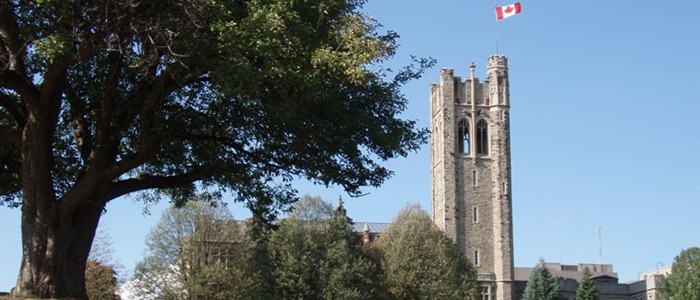
Photo: Jane Bowles
University College behind an old apple tree on University Hill
An arboretum is a botanical garden where trees and shrubs are cultivated for scientific, conservation, educational and ornamental purposes. Aesthetically and functionally, it has a major role in the greening of the environment.
The Sherwood Fox Arboretum encompasses all the planted trees and shrubs in the manicured areas on campus at Western. It represents a diversity of woody plants hardy in temperate regions throughout the northern hemisphere. The Sherwood Fox Arboretum contains a larger variety of trees than can be found in parks or nurseries and thus has an important role in public education and scientific research. The trees are catalogued and mapped and many are labelled for easy identification.
The Western University Tree Dashboard
To grasp the quantity and variety of trees on campus, The Western University Tree Dashboard is available to explore and identify the native, commemorative and donated trees throughout the main campus. This resource is provided courtesy of Liz Sutherland and the Geographic Information Systems (GIS) at Western Libraries.
A Tour of Select Trees in the Sherwood Fox Arboretum
For a closer look at some of the noteworthy species that are within the arboretum, this storymap is a great resource to view more detailed information ranging from the taxanomic name to pertinent facts about each tree.
History and Objectives

In 1916 the University of Western Ontario purchased the 150 acre Bellevue Farm, known as the Kingsmill property, to be the site of the new campus. The Kingsmill house stood in the wooded area next to Middlesex College. Access was from Western Road along a lane flanked by Black Walnut trees. A double row of these trees in front of Middlesex College still marks the end of the driveway. In 2012 the Kingsmill family dedicated a plaque at this location. One or two remnant trees also persist near the McIntosh Gallery. In 2002 Netta Kingsmill Brandon (Arts, 1944) donated a commemorative grove of Black Walnuts near the McIntosh Gallery to recall the avenue.
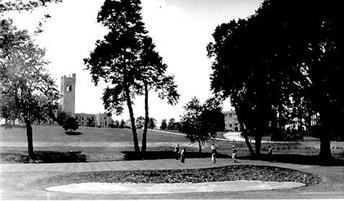
Additional land was purchased in 1917, 1922 and 1932 to extend the main campus. The London Hunt and Country Club operated a golf course on part of the property and continued to rent the land for a number of years.
The University moved to the present campus in 1923 when the Arts Building (now University College) was completed. The entrance to the campus was still from Western Road, but experts advised that a bridge be built over the Thames River as the main approach to the University. The bridge was completed in November, 1923.
Maintaining the natural beauty of the new campus was a priority with the Board of Governors. Col. J. B. Maclean, president of the Maclean Publishing, looked over the grounds from the Board room in the University College tower. He saw landscaping possibilities that used the contours and existing forest areas. He financed a plan to landscape the campus in the style of grand English country houses . Gordon Culham, pupil of the Olmsted Firm who designed Central Park in New York City, was hired to do the job. Culham later become first President of The Ontario Association of Landscape Architects. In 1966, he was granted an honorary Doctor of Laws in recognition of his contribution to the physical development of Western.
The unemployment relief system during the Great Depression funded the landscaping programme. Dead trees were cleared from the woodlots and the river bank was planted to prevent erosion. The Forestry Department of Ontario donated 10,000 trees. The main approach from Richmond Street was altered to provide a vista up University Hill. By 1936, 12,000 trees had been planted at a cost of less than $2000.
In 1981 Dr. George Connell, then President of Western designated all the trees in the manicured areas of campus as The Sherwood Fox Arboretum. Dr. J.B. Phipps was appointed as the Arboretum's first Director.
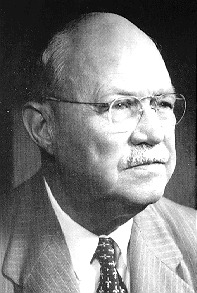
Dr. W. Sherwood Fox had been hired to teach in the Classics Department in 1917 and became Dean of Arts in 1919. In 1928, at a ceremony celebrating Western's Golden Jubilee, he was inaugurated as President, a role he filled until 1947. During his term of office he oversaw the campus landscaping project.
Sherwood Fox was an inveterate botanist. He added numerous pressed plant specimens to the UWO Herbarium. In his Reminiscences (1964) he stated that the abundance of Tulip Trees in southwestern Ontario helped lure him to Western. He remarked that the Tulip Tree was the first tree he learned to identify as a boy of nine in Erie, Pennsylvania. After his retirement, Dr. Fox wrote some three dozen articles about the trees of southwestern Ontario for The London Free Press. These are collected in a scrapbook in the J.J. Talman Regional Collection in the Weldon Library. The original draft manuscripts are in the archives of the Sherwood Fox Arboretum.
The original objective of the Sherwood Fox Arboretum was to grow on campus as many as possible the several thousand kinds of trees and shrubs that can survive in this climate. In 2003, Dr. Jane Bowles, Director of the arboretum, signed the International Agenda for Botanic Gardens in Conservation that provides a common global framework for botanic garden policies, programmes and priorities in plant conservation. While respecting the original objectives of the arboretum, the new focus is on species native to southwestern Ontario. The current arboretum holdings include some 2,400 trees of 350 species. Grounds Maintenance and Recycling of Facilities Management at Western is responsible for most of the campus landscaping and planting. The Arboretum curates this living collection and is responsible for mapping, tracking and labelling the trees.
A Guide to the Sherwood Fox Arboretum, published in 1991 gives an overview of the Arboretum and although the map is out of date, it provides a printed list of the collections.
Much of the historical information was obtained from: "Western-1878-1953" by James J. Talman and Ruth Davis Talman, published by the University of Western Ontario in 1953.
Photos Through the Years
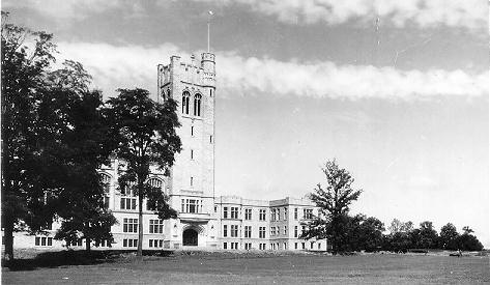
These photographs document some of the changes on campus since the early years. Old photos are from the J.J. Talman Regional Collection of the Western Libraries.
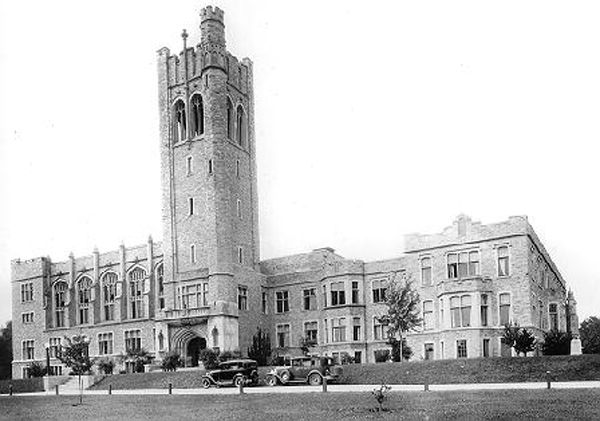
University College circa 1930. The large tree on the right in the picture above has been removed to make way for the road. The small sapling in the right foreground is now the huge Copper Beech that graces the top of University Hill.
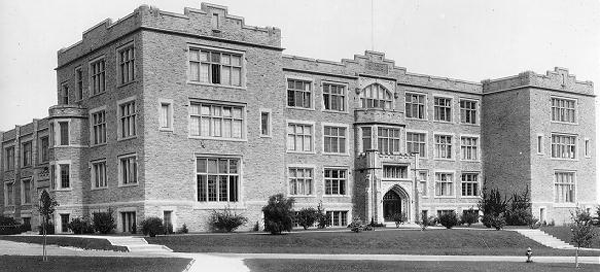
Natural Sciences, now the Physics and Astronomy Building, circa 1930. During World War II more shrubs and trees were planted in front of the basement windows to help conceal classified research on radar. The shrubs were all removed during building renovations in 2011.
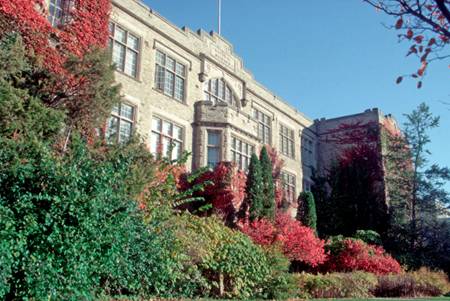
Shrubs in front of the Physics and Astronomy Building in May 2005 [photo Alan Noon]
About Dr. W. Sherwood Fox

Dr. W. Sherwood Fox was The University of Western Ontario's third president from 1927-1947. Dr. Fox had a keen interest in botany and the rest of the natural world. The book, Sherwood Fox of Western, Reminiscences of William Sherwood Fox, published by Burns and MacEachern Ltd, Toronto, 1964, is a well-written account of his life and details Sherwood Fox's many interests. After reading it, one understands why the Sherwood Fox Arboretum was so named.
Other publications by W. Sherwood Fox
- Mythology of Greece and Rome*, 1917
- Sources of the Grave-Scene in Hamlet*, 1923
- Letters of William Davies, Toronto (1854-1861)*, 1945
- A Century of Service: a History of the Talbot Street Baptist Church, 1845-1945, 1945
- "Tain't Runnin' No More: the Story of Grand Bend, the Pinery and the Old River Bed, 1946
- Scrapbook of Newspaper Clippings on Ontario Trees*, 1948-1950
- St. Ignace: Canadian Altar of Martyrdom, 1949
- The Bruce Beckons: the Story of Lake Huron's Great Peninsula, 1952
- On Friendship, 1953
- Silken Lines and Silver Hooks: a Life-Long Fisherman Recounts His Catch, 1954
- Some Trees and Shrubs of the Carolinian Zone of Southern Ontario*, with James H. Soper, 1952-1954
- 'Tain't Runnin' No More-Twenty Years After: the Story of Grand Bend and the Pinery and the Watershed of the Aux Sables River, 1958
Most of these publications are holdings in both the Western library system and the London Public Library system; those marked with an asterisk are held only at Western.
Links
BOTANIC GARDEN ORGANIZATIONS
North America
American Public Gardens Association: The APGA is committed to increasing the knowledge of public garden professionals throughout North America through information sharing, professional development, networking, public awareness, and research so they have the tools to effectively serve visitors and members.
The Sentinel Plant Network contributes to plant conservation by engaging public garden professionals, volunteers, and visitors in the detection and diagnosis of high consequence pests and pathogens.
International
Botanic Gardens Conservation International: BGCI is an international organisation of over 700 gardens in 118 countries that exists to ensure the world-wide conservation of threatened plants. The continued existence of these plants are intrinsically linked to global issues including poverty, human well-being and climate change
SOME SELECTED BOTANIC GARDENS
Royal Botanical Gardens: Located in Burlington Ontario, the RBG (also known as the Really Big Garden) this is the largest botanic garden in Canada and a global leader in bringing plans and people together.
Gardens of Fanshawe College and A.M. Cuddy Gardens: Relatively new the arboretum at Fanshawe College is developing fast.
The Arboretum, University of Guelph: Just up the road and well worth a visit.
Royal Botanic Garden Kew: London is London. Why not visit the other London?
Boyce Thompson Southwestern Arboretum: For something completely different, why not visit the desert in the middle of a Southwestern Ontario winter?
Arnold Arboretum: Closer to home at Harvard University is a collection of 9,368 accessions. This site contains a searchable index for obtaining information on any plant in their collection. As an example, searching for Acer gives 144 matches ranging from Acer argutum to Acer x zoechense.

